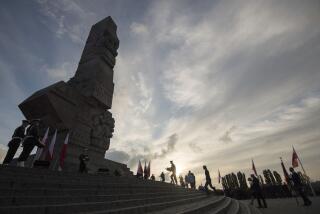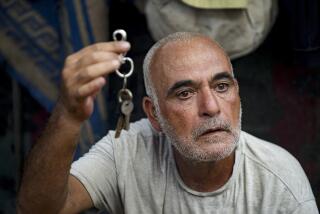The Rebirth of Hope : Encouraged by Release of Wartime Records, Holocaust Survivors Try to Learn About Relatives’ Fates
In 1939, 19-year-old Daniel Alspektor said goodby to his family, fled German-occupied Warsaw with a knapsack of canned food and headed for the Polish-Soviet border. A rebellious refugee, he was imprisoned by the Soviets before being freed to join the Polish army.
The same year, 17-year-old Nadya Dritter was smuggling bread from the Polish-Soviet border to her family in the Warsaw Ghetto. Her blue eyes and blonde hair helped her evade attention until she was captured and sent to work in Germany, first on a farm and later in a typewriter factory.
Dritter and Alspektor, both Jews, returned to their bombed-out neighborhood at the end of the war in hopes of tracing relatives they had left behind. They found nothing but each other and married in December, 1945.
Even in the years hence, Nadya--now known as Nancy--”never found one soul to call a relative,” Daniel Alspektor, now 70, said from their home in Sepulveda.
She had a sister, a niece and nephew, and 11 aunts and uncles, most of whom were surnamed Lindenholtz. Daniel Alspektor left behind his parents and three siblings. “I don’t think they’re alive,” conceded the retired commercial artist, who immigrated with his wife to New York in 1949 and moved to California 10 years later.
“I closed my chapter,” said Nancy Alspektor, 69. “I didn’t have any hope anymore.”
But hope has been resurrected since Soviet authorities last year released records of 400,000 people who were held in Nazi camps on the Eastern front. The files include 65,000 death certificates from Auschwitz, names of 130,000 non-Jewish Poles who were interned in labor camps and information on 200,000 people from concentration camps: Gross Rosen, Buchenwald, Sachsenhausen.
The documents had been seized by the Red Army when it liberated the camps in 1945 and held in Soviet archives.
“This is a major find of many magnitudes more information than we had before,” said Steven F. Mandell, program administrator of the Holocaust and War Victims Tracing and Information Center of the American Red Cross in Baltimore. The center opened Sept. 24 as a clearinghouse for inquiries about the records.
The Alspektors and about 20 other San Fernando Valley families are among the 2,500 people throughout the United States who have filed search requests with the center. Formal inquiries are made through local Red Cross chapters, whose officials tell Holocaust survivors not to expect results for at least a year.
“This generation is getting older, and they want to close this chapter in their lives before they die,” Mandell said. “There’s this aching of wanting to know what happened. It takes an enormous amount of courage to do so.”
Penny Lehman, a Red Cross caseworker in Van Nuys, interviewed the Alspektors about their last contact with missing relatives. She says many of the people filing inquiries are telling their survival stories for the first time. “Some of their experiences were so terrible they had to put it behind them to survive emotionally,” she said.
For Stanley Alspektor, who accompanied his parents to the interview, his father’s story was a revelation. “He kept saying, ‘Dad, I never knew this. You never told me,’ ” Lehman said.
The Soviets gave no official reason for releasing the archives. But the country’s new openness and its gratitude for international aid during the 1988 Armenian earthquake are believed to have played a role, Mandell said.
The International Red Cross received permission in 1989 to go to Moscow and microfilm the 46 handwritten books of death records, adding them to the 43 million documents already held at the International Tracing Service in Arolsen, in what was once West Germany. The Red Cross is hopeful that more records will surface from Eastern European nations, but none have as yet.
And so far, none of the agency’s document searches have turned up long-forgotten blood relatives, although six “peripheral matches” have been made.
In one, a Holocaust survivor from Cleveland and an American-born woman from Mineola, N. Y., filed search requests for the same three people. The Red Cross matched the two individuals, who turned out to be related by marriage. Among the 43 Red Cross volunteers who are translating the requests into German for forwarding to Arolsen, one worker discovered a boyhood friend from a village that had been wiped out in the war.
Luck is a factor in any search.
The Nazis were prodigious record keepers, filling registers with the names of those who were arrested, who boarded trains, who were transferred between camps, and who died in infirmaries and gas chambers.
Even so, much depends on whether the record writer was a countryman of the prisoner. “It would not be uncommon to have a name misspelled six, seven or eight different ways,” Mandell said. For example, he says, there are 158 spellings of the name Schwartz . Researchers “are looking for a needle in a haystack.”
But for the Alspektors--retirees with four children and six grandchildren--as well as Morrie Perlmutter of Van Nuys and Abram Stone of Agoura Hills, any word is better than continuing to live without any idea of their relatives’ fate.
“It’s something that never really leaves you,” said Perlmutter, 68, who fled his Polish birthplace in 1934 at age 11. He left behind a brother, Chaim, then 24, and a 22-year-old sister, Anna.
After the war, Perlmutter learned that Jews from his hometown, Bialystok, a textile center 105 miles northeast of Warsaw, had been sent to concentration camps at Treblinka, Auschwitz and Majdanek.
Had relatives survived, “they would have contacted us,” he said. “We assumed they had been murdered.”
Thus Perlmutter doesn’t expect a miraculous reunion to ensue from his search request, filed through the Van Nuys Red Cross chapter. Instead, he hopes to learn “exactly what their fate might have been, where and what happened and to put it to rest. It becomes like an unfinished symphony,” said Perlmutter, who settled in Los Angeles in 1946 and operated a Sherman Oaks shoe store, retiring in 1987.
Having first immigrated to Toronto with his parents and three siblings, Perlmutter joined the Canadian army at 19 and spent the final four years of the war with an antitank regiment in Europe.
Stone also was 19 when he became the first person in his family to be ordered into a German labor camp in 1940. Over nearly five years, as he was shuttled, sometimes in open cattle cars, among eight concentration camps in Poland and Germany, he helped build the Autobahn, unloaded steel from trains and worked on the railroad.
He still bears scars on his head and back from a beating by German guards, who discovered that he had been given bread by a sympathetic Polish foreman. And his left arm remains branded with an identification number: 176658.
“I was one of the few lucky to survive,” said Stone, 69, who was liberated on April 10, 1945, from the Langenstein camp in Germany by Gen. George Patton’s 3rd Army. Nearly 24, he was a walking skeleton, weighing less than 100 pounds.
Stone came to Los Angeles in 1950. He had co-owned two liquor stores and sold his remaining shop, in Sylmar, when he retired in 1988. He and his wife, Dina, have a daughter and two grandchildren.
His brother, Morton, 68, survived Auschwitz, but not before he saw their mother and sister perish.
It is information about their father, Israel, that they seek through the Red Cross. The patriarch had been held in Auschwitz with most of the family, who had lived in Niemce, Poland, a coal-mining town near the German border. He was dispatched from the camp on a forced cleanup of the Warsaw Ghetto after the uprising and didn’t return.
“He never came back. Nor did anyone else,” Stone said. He surmises that his father was shot or died of typhus. “I’d like to find where he was buried.”
More to Read
Sign up for Essential California
The most important California stories and recommendations in your inbox every morning.
You may occasionally receive promotional content from the Los Angeles Times.









